As an Amazon Associate KitchenwareSets.com earns from qualifying purchases.
11 Stunning 70s Style Kitchen Ideas You Will Love
Feeling tired of the same old all-white, minimalist kitchens you see everywhere? Does your cooking space feel a bit sterile, lacking the personality and warmth that makes a house truly feel like a home? If you’re craving a design that’s bold, inviting, and full of free-spirited charm, it might be time to look back in time for some groovy inspiration.
The 1970s was an era of self-expression, and its interior design reflects that perfectly. Kitchens were no longer just utilitarian work zones; they became the vibrant, social heart of the home. This shift resulted in spaces filled with earthy colors, unique patterns, and natural materials that are making a huge comeback today for their cozy and nostalgic appeal.
Ready to infuse your home with some of that retro magic? This guide, updated for 2025, is packed with stunning and achievable ideas to help you create the 70s style kitchen of your dreams. The 1970s kitchen aesthetic is a design trend characterized by bold earthy colors like avocado green and harvest gold, groovy geometric patterns on walls and floors, and the extensive use of natural wood tones in cabinets and paneling, creating a warm, personality-filled space. We’ll show you how to blend this iconic look with modern functionality for a kitchen that’s both stylish and practical.
Feeling Uninspired by Your Modern Kitchen? Here’s How to Channel Groovy 70s Style
If you’re looking to swap out stark minimalism for something with a bit more soul, you’ve come to the right place. The 70s kitchen aesthetic is all about creating a space that feels lived-in, comfortable, and ready for entertaining. It’s a design style that celebrates warmth, nature, and a touch of funkiness. This guide, updated for 2025, breaks down the core elements and provides actionable inspiration to help you bring this vibrant look into your own home, blending the best of retro charm with today’s needs.
What Defines a 70s Kitchen Vibe?
The key to a 70s kitchen vibe is a distinctive mix of earthy colors, bold geometric patterns, natural wood finishes, and an open, social layout. These elements work together to create a space that is both visually dynamic and incredibly inviting.
To really nail the look, focus on these defining characteristics:
- Earthy Color Palettes: Think warm and grounded. The iconic colors of the era were avocado green, harvest gold, burnt orange, and warm brown, often used in bold, confident applications on everything from appliances to walls.
- Bold Geometric Patterns: Funky and abstract patterns were everywhere. You’d find them on linoleum floors, wallpaper, and tile backsplashes, adding a layer of groovy energy to the room.
- Natural Wood Finishes: Darker wood tones were king. Cabinets were often made of walnut, oak, or redwood, and wood paneling on walls was a popular choice to add depth and warmth.
- Emphasis on Social Spaces: The 70s saw the rise of the open-concept layout. Kitchen islands, breakfast nooks, and pass-through windows became popular features, transforming the kitchen into a hub for family and friends to gather.
11 Stunning 70s Style Kitchen Ideas You’ll Actually Want to Try (Updated for 2025)
Ready to dive in? We’ve curated a list of the best 70s-inspired kitchen ideas that feel fresh, stylish, and totally achievable today. From full-scale transformations to simple, budget-friendly decor updates, you’ll find plenty of inspiration to create a kitchen that’s packed with personality.
@highwaychildvintage enjoying a sunny morning in our 1970s styled kitchen 🧡🪴✨ #70sstyle #maximalism #1970saesthetic #vintagehomedecor #groovyinterior #spaceagedesign #1970skitchenmakeover #retrokitchens
1. Embrace Bold Earthy Colors
The most direct way to channel the 70s is by embracing its iconic, earthy color palette. Don’t be afraid of colors like avocado green, harvest gold, and burnt orange; when used thoughtfully, they create a warm and energetic atmosphere that feels both nostalgic and fresh.
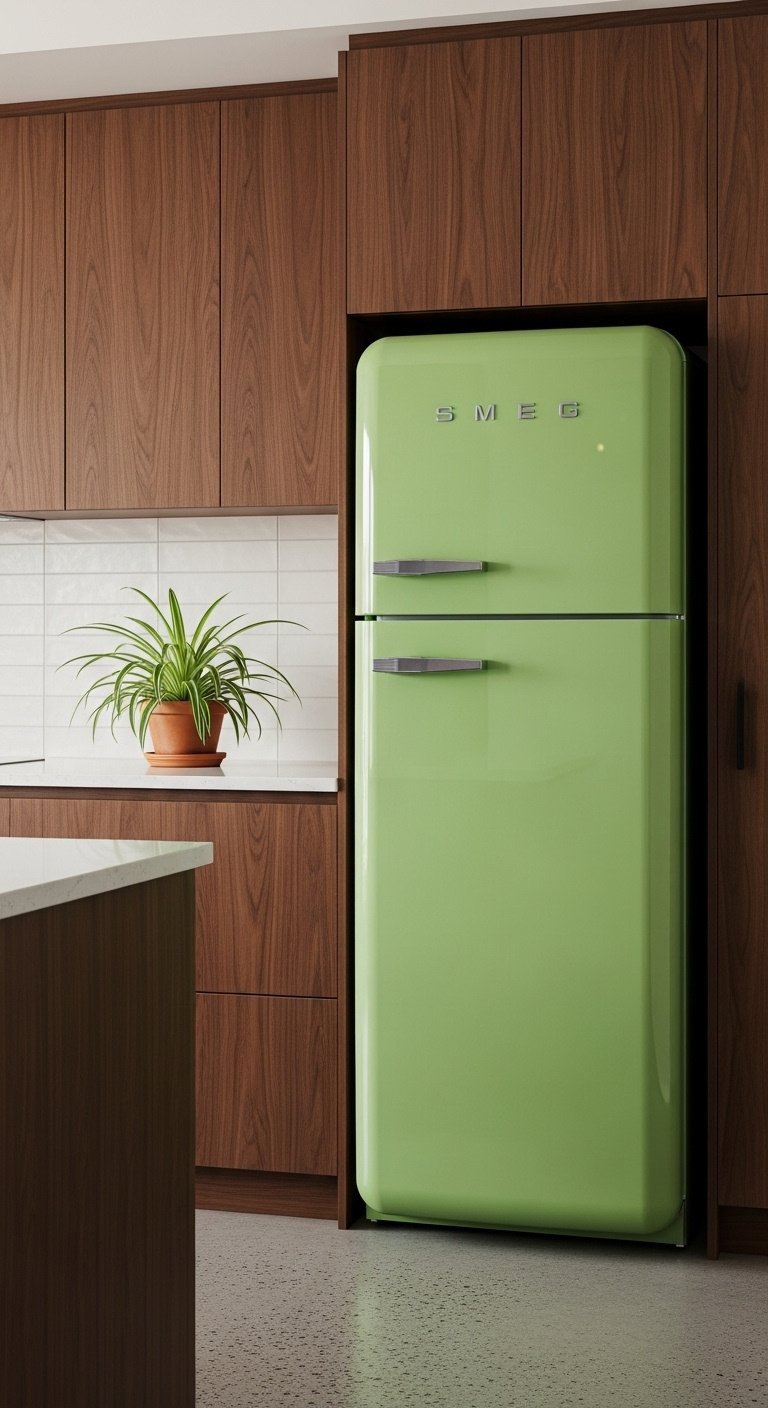
- Materials Needed: Painter’s tape, drop cloth, primer, paint roller/brush, and a 70s-inspired paint color (e.g., a modern avocado green or warm gold).
- Step-by-Step Directions:
- Select Your Canvas: Choose a single accent wall or a set of upper/lower cabinets to paint. Avoid painting everything to keep the look modern.
- Prep the Area: Clean the surface thoroughly. Use painter’s tape to create clean lines and protect surrounding areas.
- Prime First: Apply a coat of high-quality primer, especially if painting over a dark color or slick surface like laminate. Let it dry completely.
- Apply Color: Apply 2-3 thin coats of your chosen 70s color, allowing each coat to dry before applying the next for a smooth, professional finish.
Pro-Tip: “For a more subtle nod, instead of painting walls, find small appliances like a toaster or stand mixer in harvest gold or burnt orange. This adds a pop of retro color without overwhelming the space.”
“Pin this 70s color inspiration for your kitchen mood board!”
2. Incorporate Groovy Geometric Patterns
A key element of 70s design is the use of bold, groovy, and often nature-inspired geometric patterns. Incorporating these through a backsplash, wallpaper, or even floor tiles can instantly give your kitchen a funky, retro personality.
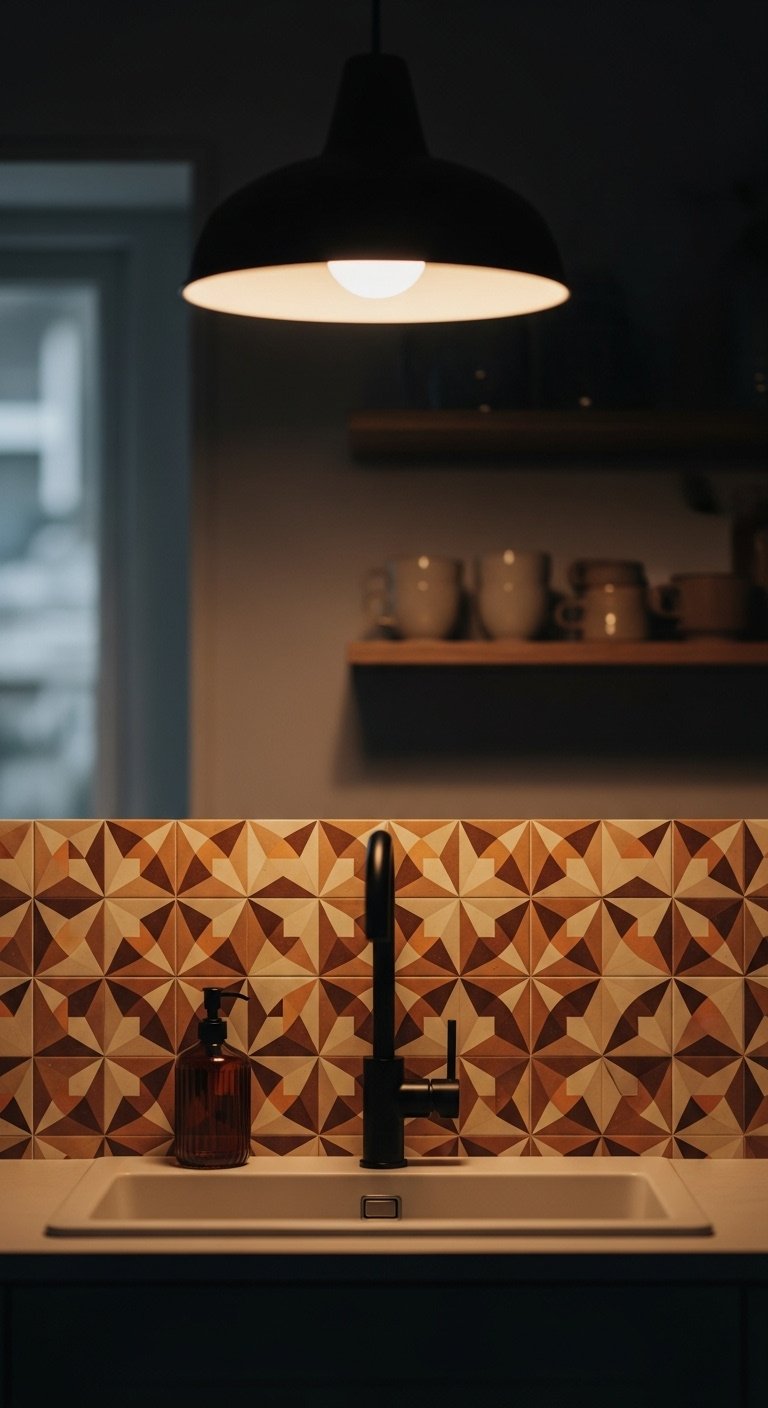
- Materials Needed: Peel-and-stick geometric tiles, measuring tape, utility knife, level.
- Step-by-Step Directions:
- Measure & Clean: Measure your backsplash area and clean it with a degreaser to ensure the tiles adhere properly.
- Plan Your Layout: Start from the center of the longest wall and work your way out. Use a level to draw a guideline for the first row.
- Peel & Stick: Peel the backing off the first tile, align it with your guideline, and press firmly. Overlap the tiles slightly as directed by the manufacturer.
- Cut to Fit: Use a sharp utility knife to carefully cut tiles to fit around outlets and at the end of rows.
Lesson Learned: “Always buy about 10% more peel-and-stick tile than you think you need. This accounts for mistakes and tricky cuts, saving you a trip back to the store.”
“Save this funky tile idea to your ‘Dream Kitchen’ board!”
3. Utilize Rich Wood Tones
The foundation of many 70s kitchens was the extensive use of rich, dark wood tones. Materials like walnut, oak, and redwood were popular for cabinets and wall paneling, creating a natural, cozy, and grounded feel that is highly sought after today.
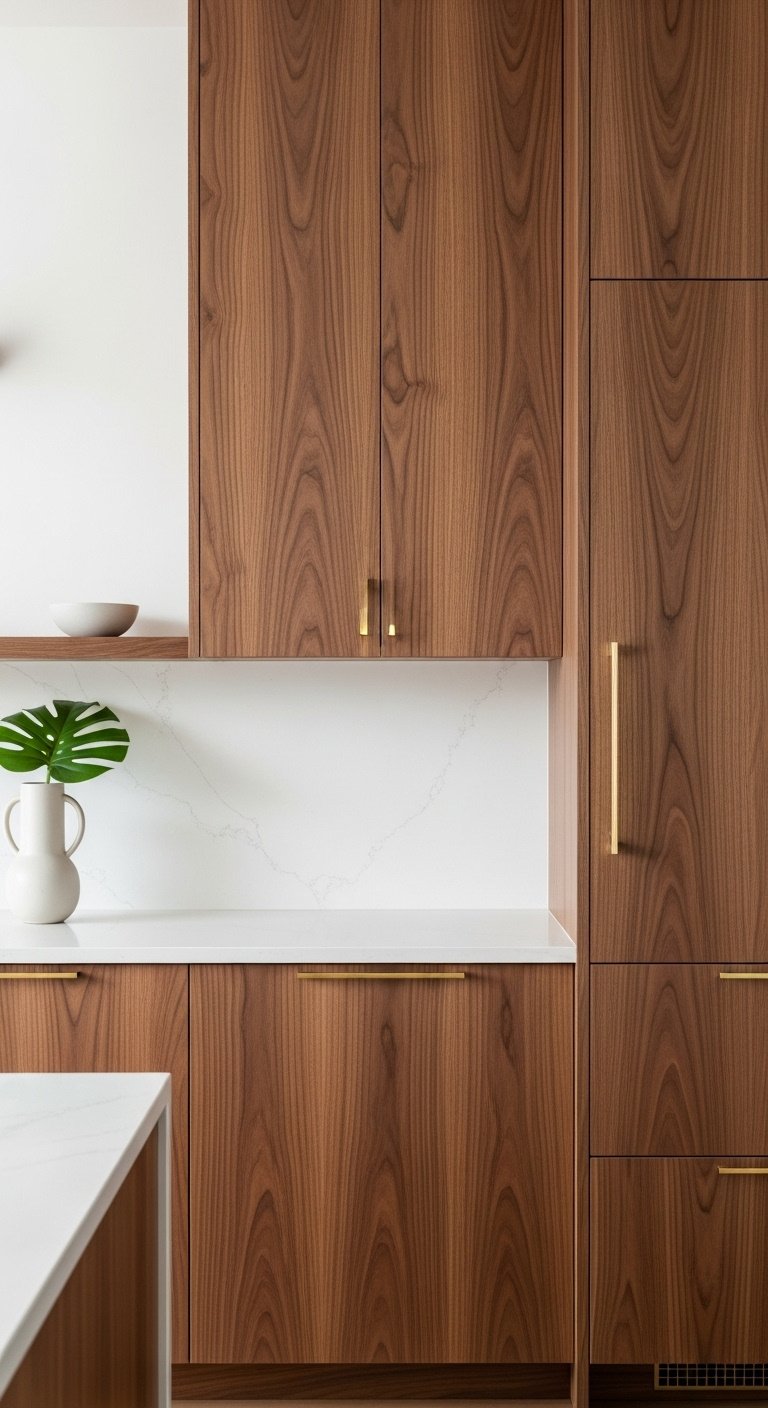
- Materials Needed: Floating wood shelves, stud finder, level, drill, wall anchors, screws.
- Step-by-Step Directions:
- Choose Your Wood: Select shelves in a rich wood tone like walnut or teak to capture the 70s feel.
- Locate Studs: Use a stud finder to locate the wall studs for secure mounting. Mark their locations lightly with a pencil.
- Mark & Level: Hold the first shelf bracket against the wall at a stud location. Use a level to ensure it’s straight and mark the drill holes.
- Drill & Mount: Drill pilot holes and secure the brackets to the wall using screws (and anchors if not in a stud). Attach the wood shelf to the brackets.
Pro-Tip: “To balance the dark wood, pair it with light countertops like white quartz and a simple, light-colored backsplash. This contrast keeps the kitchen feeling bright and modern.”
“Love wood cabinets? Pin this for inspiration!”
4. Introduce Sleek Industrial & Chrome Touches
Alongside earthy elements, the 70s also had a futuristic, space-age side, which you can channel with sleek industrial materials like polished chrome and stainless steel. These metallic finishes provide a cool contrast to warm wood tones and add a touch of retro glam.
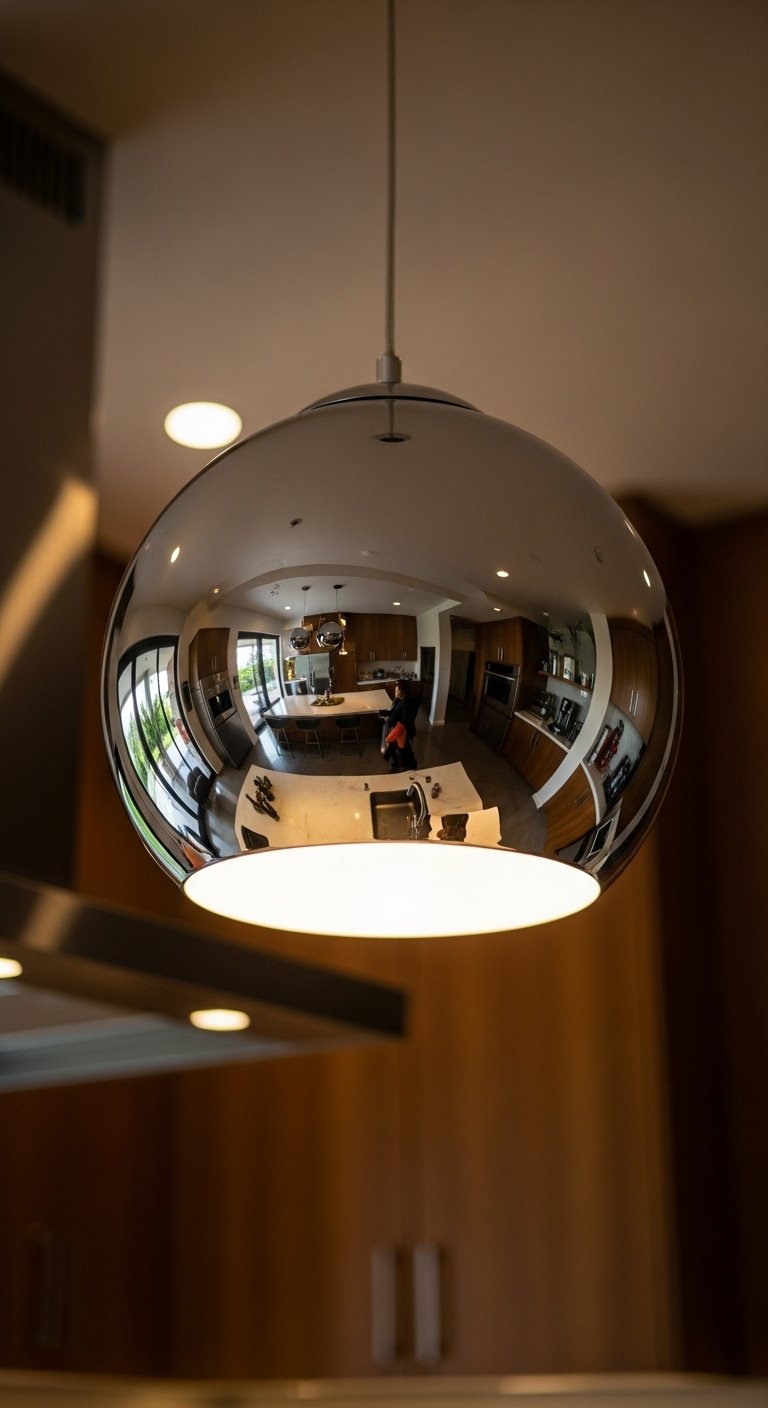
- Materials Needed: Chrome or brass cabinet pulls/knobs, screwdriver, drill (if needed), measuring tape.
- Step-by-Step Directions:
- Choose Your Finish: Select cabinet hardware in a polished chrome or a warm champagne gold/brass finish.
- Remove Old Hardware: Use a screwdriver to carefully remove all existing cabinet knobs and pulls.
- Measure & Align: If the new hardware has a different hole spacing, you’ll need a cabinet hardware jig to drill new holes accurately.
- Install New Hardware: Screw in the new knobs and pulls, ensuring they are all level and securely fastened.
Pro-Tip: “Look for vintage-style chrome pendant lights with smoked glass shades to hang over a kitchen island. This single element can instantly add an industrial 70s flair.”
“Add some shine! Pin this industrial kitchen idea.”
5. Create a Social Hub with an Island or Bar
The 70s kitchen was the heart of the home, so a key design principle was creating a central hub for entertaining and socializing, like a kitchen island or a dedicated home bar. This encourages gathering and makes the kitchen a more functional and inviting space.
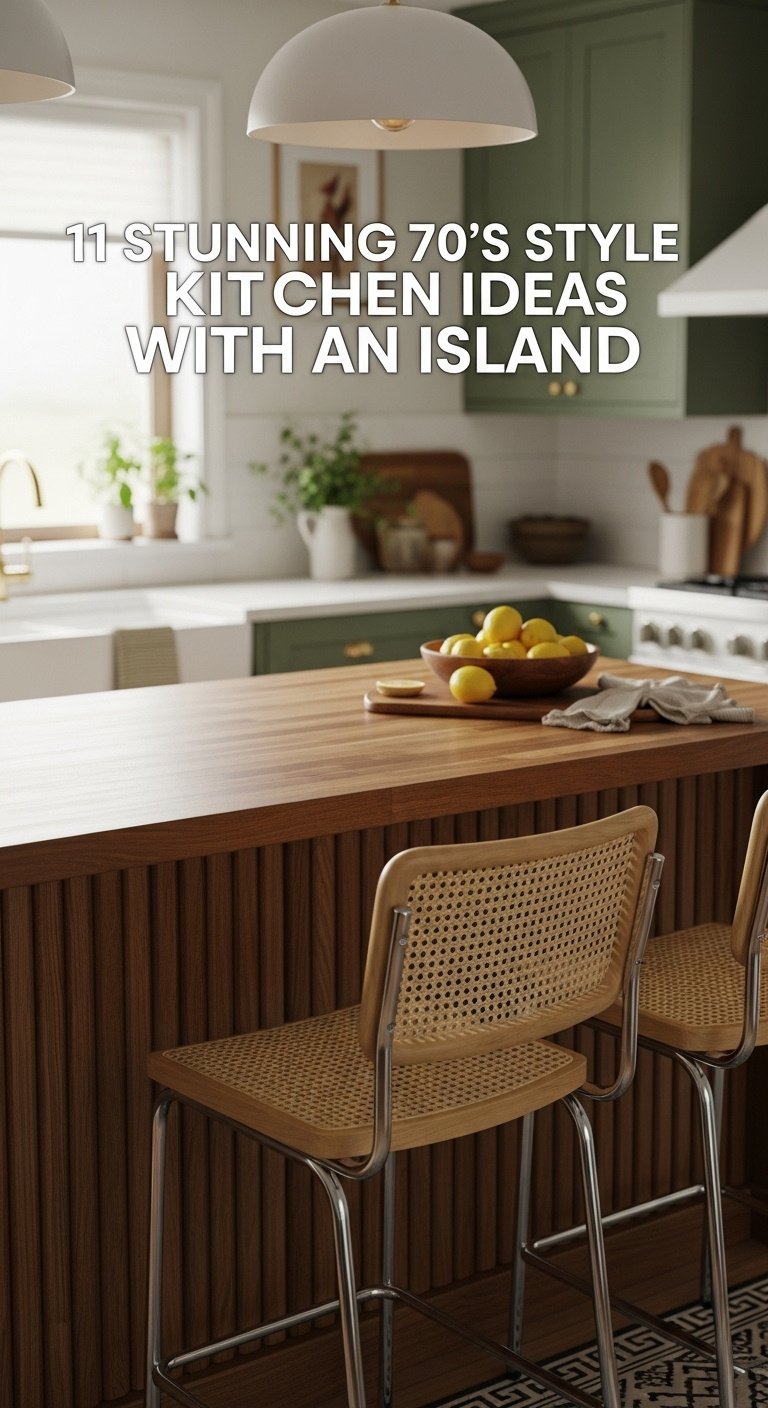
- Materials Needed: Bar cart, assorted glassware, vintage-style cocktail shaker, decanters, a small tray.
- Step-by-Step Directions:
- Find the Perfect Cart: Choose a bar cart with 70s materials like chrome and smoked glass, or rattan and wood.
- Stock the Essentials: Arrange your favorite spirits in cool decanters. Add a set of lowball glasses and highball glasses.
- Add the Tools: Include a cocktail shaker, an ice bucket, and other essential bar tools on the cart.
- Style It: Finish with a small plant, a bowl of citrus for garnish, and a few cocktail recipe books to complete the look.
Pro-Tip: “When designing a kitchen island, consider adding a ‘waterfall’ edge with your countertop material for a modern touch, or use a contrasting butcher block top for warmth and 70s authenticity.”
“Ready to entertain? Pin this kitchen island setup!”
6. Channel Boho Chic with Plants & Macramé
The bohemian, back-to-nature movement was huge in the 70s, and an easy way to capture this is to bring the outdoors in with plenty of houseplants and natural textures like macramé. This is a budget-friendly way to add life, color, and a relaxed vibe to your kitchen.
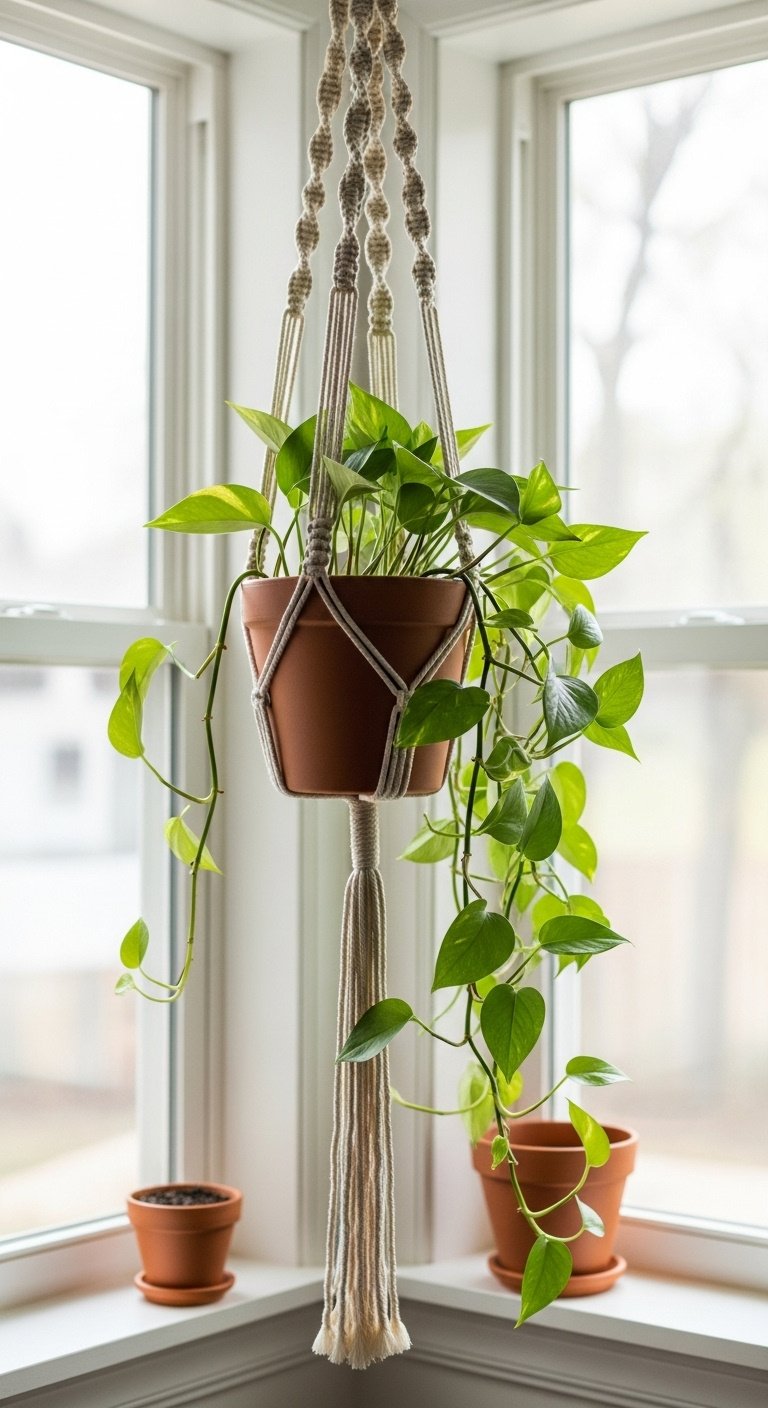
- Materials Needed: Macramé cord, a wooden or metal ring, scissors, a potted plant (like a pothos or spider plant).
- Step-by-Step Directions: (Simplified for a blog post)
- Cut & Attach Cords: Cut eight long pieces of macramé cord. Fold them in half and loop them through the ring to create your base.
- Knot the Hanger: Following a simple macramé pattern (e.g., a series of square knots), create the main body of the hanger.
- Create the Basket: About three-quarters of the way down, split the cords into groups and create a net-like structure to hold the pot.
- Finish with a Knot: Gather all the cords at the bottom and tie a large, secure gathering knot to finish it off. Trim the ends.
Lesson Learned: “Use ceiling hooks rated for the weight of your plant after watering. A wet plant is significantly heavier, and you want to ensure the hanger is secure.”
“Bring the outdoors in! Pin this boho kitchen decor idea.”
7. Go Bold with Colorful Appliances
Nothing says 70s kitchen quite like a statement appliance in a bold, eye-catching color. While avocado green and harvest gold were the original stars, modern brands offer retro-styled appliances in a whole rainbow of colors that can become the perfect focal point for your kitchen.
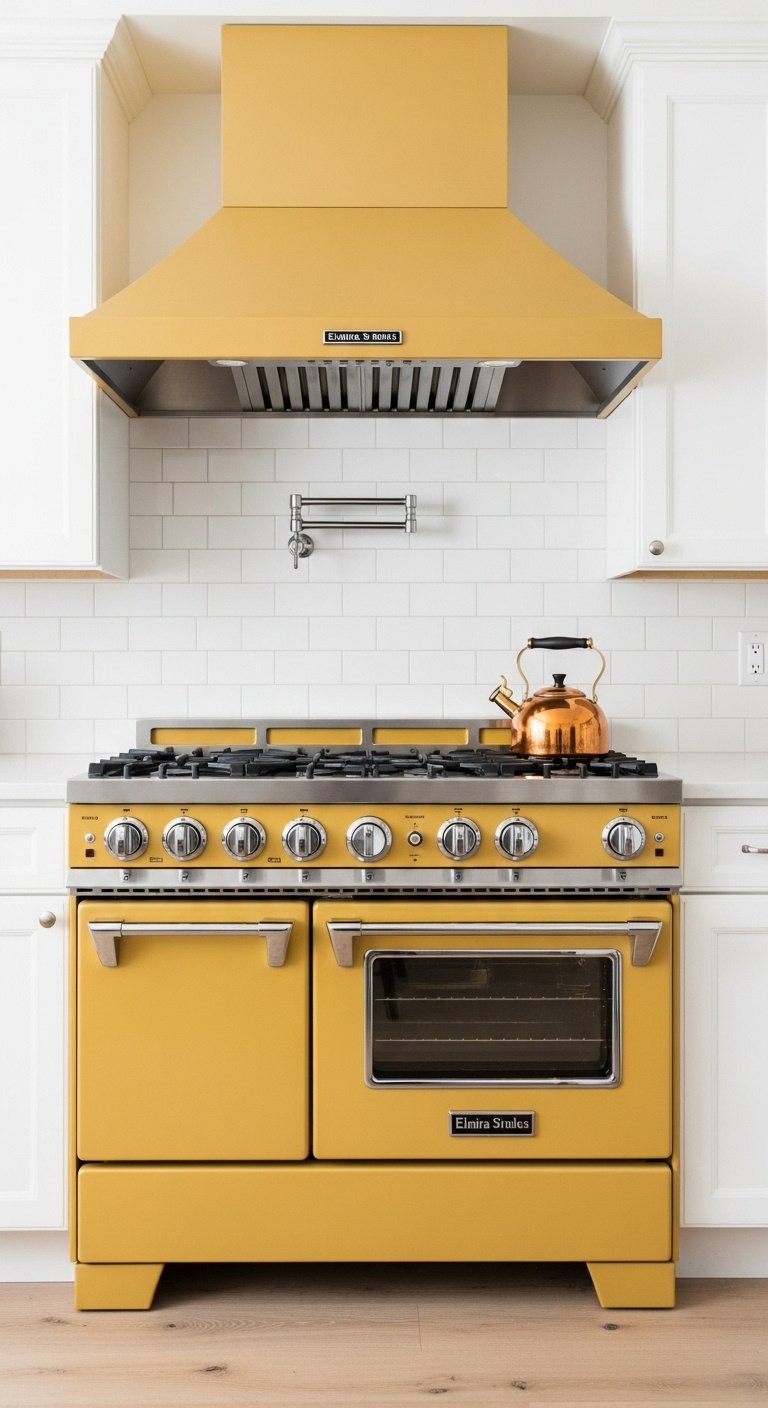
- Materials Needed: Your kitchen space, measuring tape, and a budget for a statement appliance.
- Step-by-Step Directions:
- Measure Precisely: Before falling in love with an appliance, measure the height, width, and depth of the space it will occupy. Don’t forget to measure doorways for delivery.
- Choose a Statement Piece: Decide on one major appliance to be your retro focal point, like the refrigerator or the stove.
- Select a Color: Pick a classic 70s color like harvest gold or avocado green, or go for a vibrant candy red or pastel mint green for a fun twist.
- Build Around It: Keep the surrounding cabinetry and backsplash relatively neutral to let your colorful appliance be the star of the show.
Pro-Tip: “Many brands now offer modern, energy-efficient appliances with retro styling. You get the 70s look you love with the 21st-century performance you need.”
“Add a pop of color! Save this retro appliance idea.”
8. Rethink the Layout with Open Concepts
A defining shift in 70s home design was moving towards more integrated living spaces, and the kitchen was central to this. Adopting an open-concept layout or adding features like a breakfast nook or a pass-through window can make your kitchen feel more spacious, social, and true to the era.
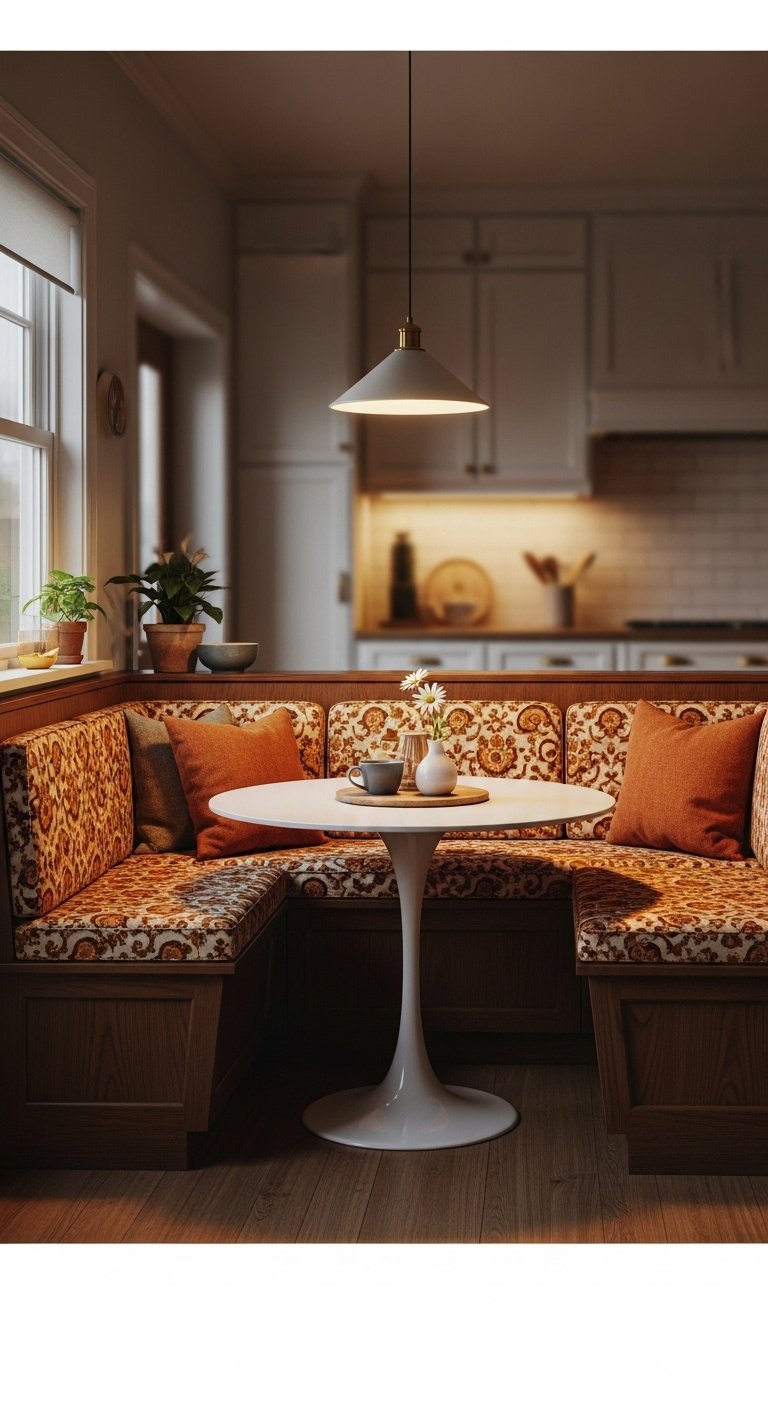
- Materials Needed: A small round or square table, two chairs or a small built-in bench, cozy cushions, a pendant light.
- Step-by-Step Directions:
- Identify a Corner: Find an unused corner in or near your kitchen that gets good natural light.
- Add Seating: Place a small table there. If space allows, a built-in banquette with storage underneath is a great option. Otherwise, two stylish chairs will work perfectly.
- Define the Space: Hang a low-hanging pendant light directly over the table to create a distinct zone and add cozy ambiance.
- Make it Comfy: Add cushions to the chairs or bench to encourage lingering over coffee.
Pro-Tip: “A pass-through window is a great way to open up a wall between a kitchen and dining/living area without a full demolition. It improves sightlines and makes passing food and drinks easy.”
“Pin this cozy breakfast nook for your future home!”
9. Accessorize with Authentic Retro Details
Sometimes, the secret to nailing a style is in the small details. Accessorizing with authentic or replica 70s kitchenware—like mushroom-themed canisters, melamine dishware, or amber glassware—is a fantastic, budget-friendly way to infuse your space with retro charm.
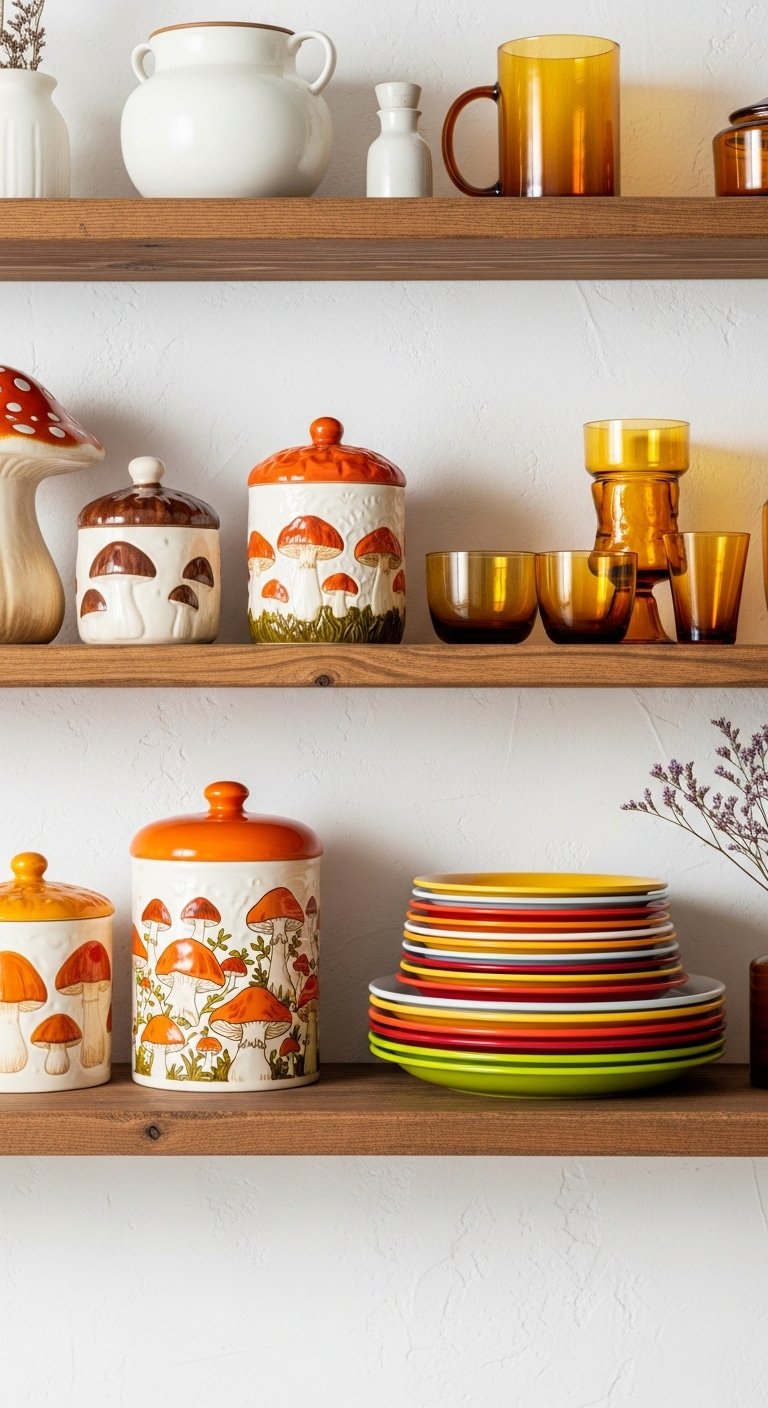
- Materials Needed: Open shelving, a curated collection of retro items (e.g., colorful melamine plates, mushroom-themed canisters, amber glassware).
- Step-by-Step Directions:
- Gather Your Collection: Hunt for authentic 70s kitchenware at thrift stores, flea markets, or online marketplaces. Look for items with bold colors and funky patterns.
- Create Visual Groups: Arrange your items on open shelves. Group items by color or type (e.g., a stack of orange plates, a cluster of green glass).
- Vary Heights: Use a mix of tall items (vases) and short items (mugs, bowls) to create visual interest.
- Leave Breathing Room: Don’t overcrowd the shelves. Allow some empty space to let each piece stand out and avoid a cluttered look.
Lesson Learned: “One of the easiest swaps is cabinet hardware. Replacing standard silver knobs with a modern ‘champagne gold’ finish instantly adds warmth and a nod to the brass hardware popular in the 70s.”
“It’s all in the details! Pin these retro accessories.”
10. Integrate Modern Elements for Peak Functionality
The best modern-retro kitchens blend the iconic style of the 70s with the high performance and durability of today’s materials and technology. This means you can have the warm, groovy look you love without sacrificing the convenience of a modern, functional kitchen.
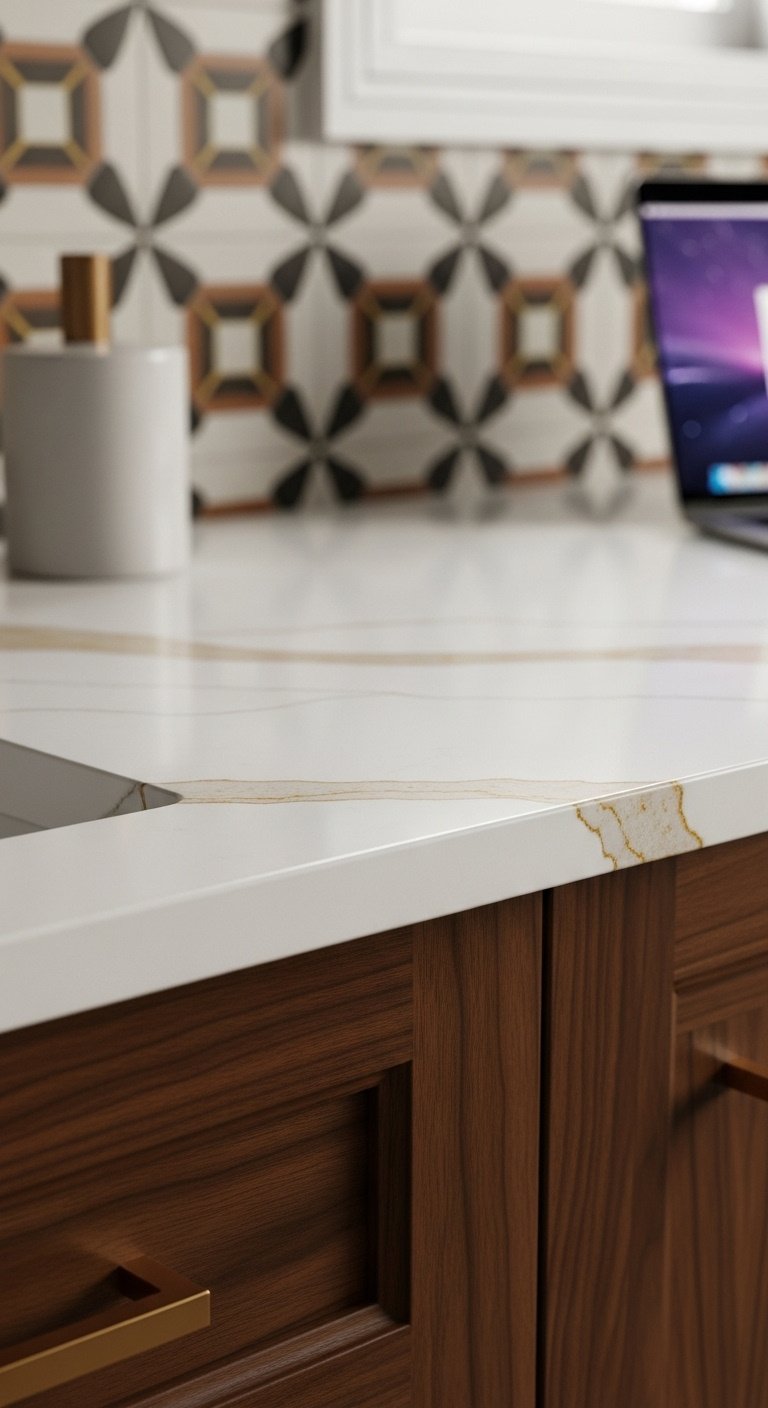
- Materials Needed: Under-cabinet LED strip lighting kit, measuring tape, cleaning cloth, scissors.
- Step-by-Step Directions:
- Measure & Clean: Measure the underside of your cabinets where you’ll install the lights. Wipe the surface clean so the adhesive will stick.
- Cut the Strip: Most LED light kits can be cut to length at designated marks. Cut the strip to fit your measurements.
- Peel & Stick: Peel the backing off the adhesive and carefully press the LED strip into place under the cabinet, usually towards the front for best task lighting.
- Connect & Conceal: Connect the power supply and neatly tuck away or tape up any excess wiring to keep it hidden.
Pro-Tip: “Choose a quartz countertop with a subtle, warm veining. It provides the durability and ease of care that 70s laminate lacked, while its gentle pattern won’t compete with bolder retro elements like a patterned backsplash.”
“Get the best of both worlds! Pin this modern-retro idea.”
11. Focus on Texture and Material Blending
A truly authentic 70s space is rich with texture, so a key design tip is to focus on layering and blending different materials. Combine the smoothness of laminate, the warmth of wood grain, the roughness of macramé, and the gloss of tile to create a kitchen that is visually and tactilely interesting.
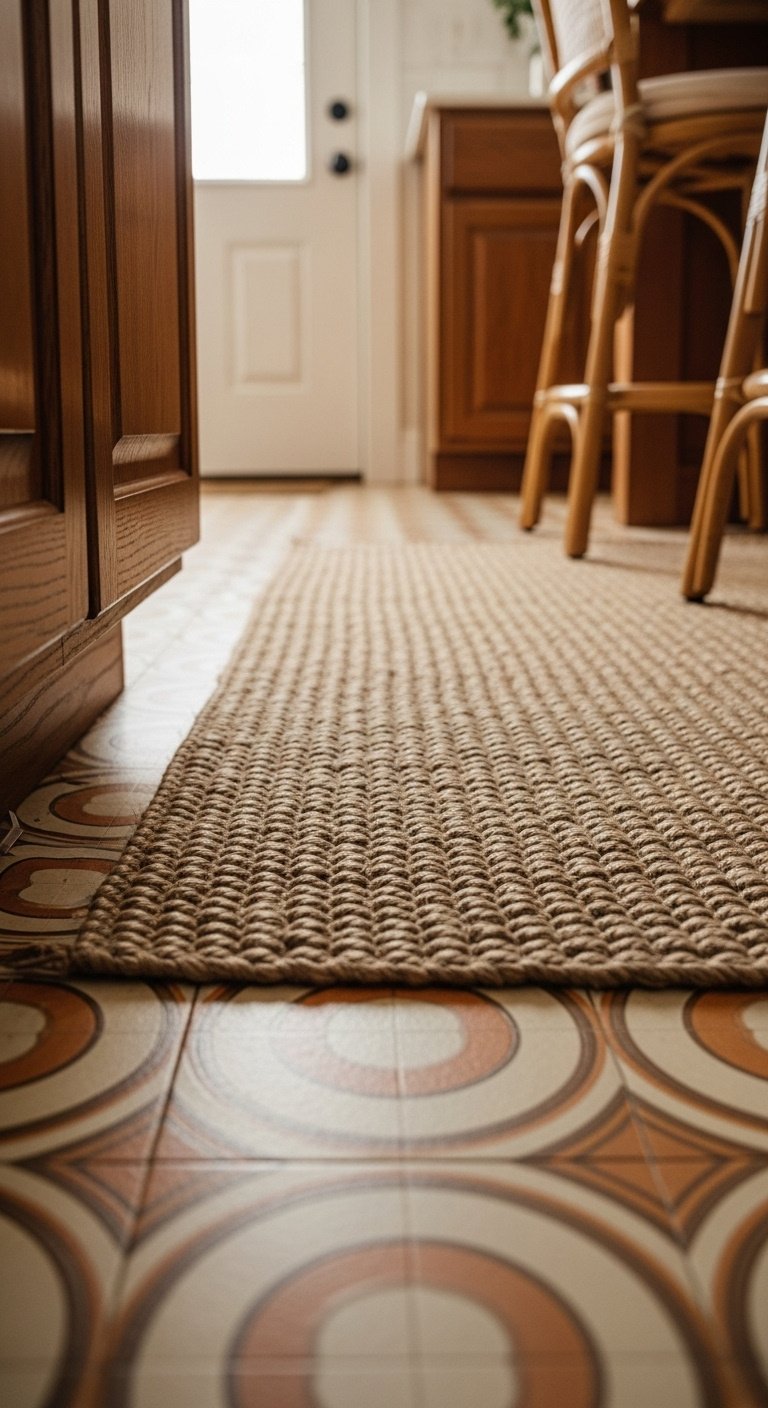
- Materials Needed: A natural fiber runner (jute or sisal), non-slip rug pad.
- Step-by-Step Directions:
- Measure Your Space: Measure the floor area you want to cover, typically the high-traffic zone between the sink and stove.
- Choose a Natural Fiber: Select a runner made of jute, sisal, or a woven wool blend. Look for one with a subtle pattern or a pop of 70s color like gold or orange.
- Add a Non-Slip Pad: Cut a non-slip rug pad to be slightly smaller than your runner. This is crucial for safety in a kitchen.
- Place and Smooth: Lay the pad down first, then place your runner on top, smoothing out any wrinkles. This simple addition adds warmth and texture underfoot.
Lesson Learned: “When blending materials, create a cohesive look by sticking to a defined color palette of 3-4 colors. For example, walnut cabinets (brown), a green tile backsplash (green), and cream countertops (cream) all work together beautifully.”
“It’s all about texture! Save this design tip.”
Key Takeaways: Your Quick Guide to 70s Kitchen Style
Here are the core principles to remember when creating your modern 70s-inspired kitchen:
- Color is Key: Embrace a warm, earthy palette of avocado green, harvest gold, and burnt orange, even if just in small accessories or a single statement appliance.
- Wood Brings Warmth: Incorporate rich wood tones like walnut or teak through cabinetry or open shelving to create a cozy, natural foundation.
- Pattern Adds Personality: Don’t be afraid of bold, groovy patterns. A geometric backsplash or funky wallpaper can be the perfect focal point.
- Texture is Everything: Layer different materials like wood, macramé, natural fiber rugs, and chrome to create a space that is visually rich and inviting.
- Modernize for Life: Blend retro style with modern functionality by choosing durable quartz countertops and energy-efficient appliances to get the best of both eras.
People Also Ask About 70s Style Kitchen
What were the kitchen trends in the 70s?
The major kitchen trends of the 1970s included bold, earthy color palettes (avocado green, harvest gold), the widespread use of dark wood cabinets and paneling, groovy geometric patterns on floors and walls, and a shift toward more open, social layouts with features like kitchen islands and breakfast nooks. Laminate countertops and colorful appliances were also iconic elements of the era.
How can I add a 70s vibe to my kitchen on a budget?
To add a 70s vibe on a budget, focus on small changes with big impact. Introduce houseplants in macramé hangers, hunt for vintage accessories like mushroom canisters at thrift stores, add a natural fiber runner, or use peel-and-stick vinyl tiles to create a patterned backsplash. Painting an accent wall in a muted burnt orange or gold is another affordable option.
Are 70s style kitchens coming back?
Yes, 70s style kitchens are experiencing a major resurgence. Designers and homeowners are drawn to the warmth, personality, and natural materials of the era as a contrast to minimalist designs. The modern take on 70s style blends iconic elements like rich wood tones and earthy colors with contemporary layouts, materials, and functionality for a fresh, nostalgic look.
What is the 3×4 kitchen rule?
The 3×4 kitchen rule is a design guideline for functionality. It suggests you should have at least three feet (36 inches) of clear walkway space between countertops and other obstacles, and at least four feet (48 inches) of space between major work zones like the sink, stove, and refrigerator to allow for comfortable movement and for multiple people to work without getting in each other’s way.
Final Thoughts
Bringing the groovy, warm, and personality-packed vibe of a 70s kitchen into your home is all about having fun and blending the best of the past with the convenience of the present. Whether you go all-in with avocado appliances or just add a few macramé hangers, embracing this style is a surefire way to create a kitchen that’s uniquely you. Which of these 70s ideas is your favorite? Let us know in the comments below
